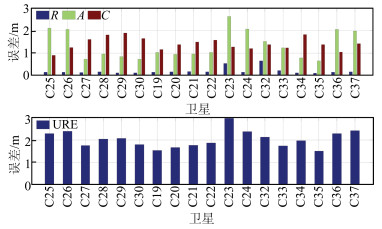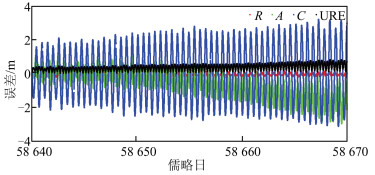Feasibility Analysis of Autonomous Orbit Determination of BDS Satellites with Inter-Satellite Links
-
摘要: 北斗三号卫星导航系统(BeiDou-3 navigation satellite system, BDS-3)在BDS-2基础上,设计实现了高速宽带星间链路网络,以期实现导航和通信的一体化建设,并为卫星自主定轨(autonomous orbit determination, AOD)技术的实现积累宝贵的实测数据。首先, 利用星间链路数据建立分布式AOD模型;然后, 利用实测的BDS-3星间链路数据,分析了18颗中圆轨道(medium Earth orbit, MEO)卫星间的建链有效率、星座构型及星间测量噪声,并讨论了轨道初值、滤波处理间隔等因素对AOD精度的影响;最后, 给出了基于北斗三号系统18颗MEO卫星星间测距数据的AOD结果,用事后精密轨道产品对其进行了评估分析。结果表明:(1)BDS-3星间链路运行稳定,每颗卫星基本可维持9条左右的星间双向测距链路,星间有效链路数和星座布局已能够支撑实现分布式导航星座的AOD;(2)轨道初始精度、滤波处理间隔等都会影响状态估计精度和收敛速度;(3)轨道初值位置精度为0.1 m、滤波处理间隔为60 s的条件下,AOD连续运行30天的用户测距误差(user ranging error,URE)精度约为0.48 m,有效验证了分布式AOD算法的有效性。
-
关键词:
- 北斗三号卫星导航系统 /
- 星间链路 /
- 自主定轨
Abstract:Objectives The BeiDou-3 navigation satellite system (BDS-3) has designed and implemented a high-speed broadband inter-satellite link (ISL) network on the basis of the BDS-2 to carry out integrated navigation and communication and accumulate valuable measured data for the autonomous orbit determination (AOD) of the satellites. With ISL data, navigation satellite systems can achieve AOD that enables satellites to update their ephemeris on-orbit without the support of the operational control segment. However, the key technologies of the AOD system of global positioning system have not been disclosed. In the last few years, some domestic scholars have carried out some useful research and exploration into AOD with simulation data. But the results of applying the ISL to AOD are still relatively few.Methods The AOD processing model was briefly reviewed on the basis of inter-satellite ranging observations, and a distributed AOD model was built with ISL data. Then, the link building efficiency, constellation geometry, and inter-satellite measurement noise of the 18 medium Earth orbit (MEO) satellites in the BDS-3 constellation were analyzed, and the influences of the initial orbit accuracy and filtering processing interval on the AOD process were also analyzed. Finally, the AOD results obtained via the measured inter-satellite ranging data on the 18 MEO satellites were given and compared with the results of the precision orbit for evaluation and analysis.Results AOD processing and performance analysis are conducted. The analysis results are as follows: (1) The BDS-3 ISLs are rather stable, with about 9 inter-satellite two-way ranging links for each satellite, and the effective ISLs and the constellation geometry could support the AOD of the distributed navigation constellation. (2) The initial orbit accuracy and the filtering interval affect the state evaluation accuracy and convergence velocity. (3) When the initial orbit accuracy is 0.1 m and the filtering interval is 60 s, the user ranging error accuracy of AOD for 30 days is 0.48 m.Conclusions The results confirm the validity of the proposed distributed AOD algorithm. -
海洋面积占全球总面积约71%,确定精细的海底地形图对海洋资源开采、水下导航、海底构造运动和海洋环流等研究具有重要意义。船载声呐探测技术是目前获取深海海底地形的主要手段。然而,该方法成本高、耗时长。有学者估计,要完成全球深海的船载测深工作大约需要200年,且耗资数十亿美元[1]。随着卫星测高技术的发展,通过其海面高数据反演的海洋重力场已具有较高的分辨率和精度,且能实现全球海域的均匀覆盖。当前,卫星测高海面重力异常的解算精度已达2~3 mGal[2]。海底洋壳与海水层间存在密度差,海底地形变化势必引起海洋重力场的扰动。因此,若能构建出海面重力异常和海底地形间的数学关系,就能实现海底地形的反演。目前已有许多海底地形反演方法被提出,主要包括线性回归法[3]、导纳函数法[4]、最小二乘配置法[5]、重力地质法(gravity-geologic method,GGM)[6-12]和模拟退火法[13]等。其中,GGM简单高效,能够满足大范围水深反演的需要[12]。
GGM起初可以通过观测重力异常和少量钻孔资料预测沉积基底深度[14]。由于沉积层密度的垂向变化较大,其效果欠佳。受益于海底洋壳与海水层的密度差几乎不随深度变化,GGM被广泛用于海底地形反演[6-7, 15]。GGM通过船测水深控制点从观测重力异常中分离长波重力异常和短波重力异常,并利用短波重力异常反演海底地形。许多学者对GGM中密度差的确定和长波重力异常的构建进行了相关研究。文献[7]采用迭代法确定密度差的经验值;文献[8]提出确定密度差的向下延拓法;文献[9]采用改进的重力地质方法(improved gravity-geologic method,iGGM)来逼近长波重力异常,有效改善了由不均匀控制点构建长波重力异常的精度;文献[16]将iGGM法应用于几内亚湾海底地形绘制,取得了较好效果,并指出对于山区反演,应采用更多的船测点及不同的最佳密度差;文献[10]考虑地形因素的影响,提出了一种基于普通克里金的地形约束因子权重优化方法来构建区域重力异常。
短波重力异常是除密度差和长波重力异常外影响GGM反演质量的另一重要因素。传统GGM使用布格板公式计算由海底地形起伏引起的短波重力异常,这是一种线性近似处理,势必会造成信息的遗漏[4]。文献[17]提出在计算短波重力异常时顾及局部地形改正,大大提高了海底地形的反演精度;文献[11]在构造短波重力异常时,采用三维直角棱柱代替布格板公式,并在西菲律宾盆地验证其方法的有效性。上述研究采用空间域积分解算地形重力效应,计算效率低,在一定程度上与GGM计算速度快且适用于大范围海域等优点相悖。此外,传统GGM利用短波重力异常恢复海底地形时,同样基于布格板公式解算,仅能恢复海底地形的线性信息。
基于上述问题,本文提出了一种改进的GGM,利用频率域重力正演和迭代反演方法恢复海底地形的非线性项,选择中国南海作为研究区,构建空间分辨率为1'×1'海底地形模型,并详细分析了影响模型精度的各种因素。
1 原理与方法
1.1 传统GGM原理
海面观测重力异常可看作两部分之和,由海底地形起伏引起的短波重力异常和由深部密度不均引起的长波重力异常,其表达式为:
$$ {g}_{\mathrm{o}\mathrm{b}\mathrm{s}}\left(i\right)={g}_{\mathrm{s}\mathrm{h}\mathrm{o}\mathrm{r}\mathrm{t}}\left(i\right)+{g}_{\mathrm{l}\mathrm{o}\mathrm{n}\mathrm{g}}\left(i\right) $$ (1) 式中,$ i $表示对应于观测重力异常格网点的位置;$ {g}_{\mathrm{o}\mathrm{b}\mathrm{s}} $、$ {g}_{\mathrm{s}\mathrm{h}\mathrm{o}\mathrm{r}\mathrm{t}} $和$ {g}_{\mathrm{l}\mathrm{o}\mathrm{n}\mathrm{g}} $分别表示观测重力异常、短波重力异常和长波重力异常。
已知水深控制点处的$ {g}_{\mathrm{s}\mathrm{h}\mathrm{o}\mathrm{r}\mathrm{t}}\left(j\right) $可以通过布格板公式近似计算,计算式为:
$$ {g}_{\mathrm{s}\mathrm{h}\mathrm{o}\mathrm{r}\mathrm{t}}\left(j\right)=2\mathrm{\pi }G\Delta \rho \left(E\left(j\right)-D\right) $$ (2) 式中,$ G $是万有引力常量;$ j $表示已知水深控制点的位置;$ E\left(j\right) $为已知控制点水深;$ D $为参考深度,通常取测深点的最大深度;$ \Delta \rho $为海底洋壳与海水间的密度差。由式(1)和式(2)可得:
$$ {g}_{\mathrm{l}\mathrm{o}\mathrm{n}\mathrm{g}}\left(j\right)={g}_{\mathrm{o}\mathrm{b}\mathrm{s}}\left(j\right)-{g}_{\mathrm{s}\mathrm{h}\mathrm{o}\mathrm{r}\mathrm{t}}\left(j\right) $$ (3) 式中,$ {g}_{\mathrm{o}\mathrm{b}\mathrm{s}}\left(j\right) $为控制点处的观测重力异常,可由实际观测重力异常数据插值得到;$ {g}_{\mathrm{l}\mathrm{o}\mathrm{n}\mathrm{g}}\left(j\right) $为控制点处的长波重力异常,经格网化处理后可获得任意格网点上的长波重力异常$ {g}_{\mathrm{l}\mathrm{o}\mathrm{n}\mathrm{g}}\left(i\right) $;根据式(1)可计算出格网点上的$ {g}_{\mathrm{s}\mathrm{h}\mathrm{o}\mathrm{r}\mathrm{t}}\left(i\right) $,应用布格板公式将$ {g}_{\mathrm{s}\mathrm{h}\mathrm{o}\mathrm{r}\mathrm{t}}\left(i\right) $转换为海底地形起伏,再添加参考深度,可获得水深格网模型$ E\left(i\right) $:
$$ E\left(i\right)=\frac{{g}_{\mathrm{s}\mathrm{h}\mathrm{o}\mathrm{r}\mathrm{t}}\left(i\right)}{2\mathrm{\pi }G\Delta \rho }+D $$ (4) 在GGM计算过程中,共涉及$ \Delta \rho $和$ D $两个参数。其中,反演结果几乎不受$ D $取值的影响,但对$ \Delta \rho $的变化十分敏感。$ \Delta \rho $的理论值为1.67 g/cm3,等于海底基岩密度2.70 g/cm3与海水密度1.03 g/cm3之差[6]。大量实践表明,GGM中$ \Delta \rho $通常远偏离于理论值,因而不具备实际物理意义,仅为经验参数[7-8, 12]。常用的$ \Delta \rho $确定方法主要有向下延拓法和迭代法[7-8]。本文采用迭代法,按一定的步长改变$ \Delta \rho $,并反演对应的水深模型。通过计算反演模型与船测水深值间的相关系数及标准差(standard deviation,STD),选取最小STD及最大相关系数对应的$ \Delta \rho $为最优密度差。
1.2 短波重力异常计算
观测重力异常的精度、水深控制点分布、所采用的插值/格网化方法、海底地形起伏状况等因素均会影响GGM的模型构建精度。传统GGM通常在平坦地形区具有较高的精度,而在复杂地形区精度较低。该现象一定程度上归咎于传统GGM仅考虑海底地形的线性项,而忽略非线性项。在式(2)中,若设定$ D=0 $,则$ {g}_{\mathrm{s}\mathrm{h}\mathrm{o}\mathrm{r}\mathrm{t}}\left(j\right) $与海底地形间通过布格板项$ 2\mathrm{\pi }G\Delta \rho E\left(j\right) $表示为一一对应的线性关系,而实际上海面重力异常与海底地形间应为非线性关系[11]。文献[17]将$ {g}_{\mathrm{s}\mathrm{h}\mathrm{o}\mathrm{r}\mathrm{t}}\left(j\right) $表示为局部地形改正项$ \mathtt{δ}{g}_{\mathrm{T}\mathrm{C}} $和布格板项之和,计算式为:
$$ {g}_{\mathrm{s}\mathrm{h}\mathrm{o}\mathrm{r}\mathrm{t}}\left(j\right)=2\mathrm{\pi }G\Delta \rho E\left(j\right)+\mathtt{δ}{g}_{\mathrm{T}\mathrm{C}} $$ (5) 传统GGM仅考虑式(5)中的线性部分,而忽略非线性项$ \mathtt{δ}{g}_{\mathrm{T}\mathrm{C}} $。这在平坦地形区是可行的,然而在复杂地形区,忽略非线性项会引入系统误差,从而降低反演精度[17]。$ {g}_{\mathrm{s}\mathrm{h}\mathrm{o}\mathrm{r}\mathrm{t}}\left(j\right) $除了按式(5)表示外,亦可直接表示为:
$$ {g}_{\mathrm{s}\mathrm{h}\mathrm{o}\mathrm{r}\mathrm{t}}\left(j\right)=\Delta g\left(x, y, z, E, \Delta \rho \right) $$ (6) 式中,$ (x, y, z) $为计算点三维坐标;$ E $为海底深度。
为了兼顾精度与计算效率,本文采用文献[18]的Parker公式计算短波重力异常,公式为:
$$ F\left(\Delta g\right(i\left)\right)=2\mathrm{\pi }G\Delta \rho {\mathrm{e}}^{-\left|\overrightarrow{k}\right|d}\sum\limits_{n=1}^{{\infty }}\frac{{\left|\overrightarrow{k}\right|}^{n-1}}{n!}F\left({E}^{n}\right(i\left)\right) $$ (7) 式中,$ F $表示二维傅里叶变换;$ \overrightarrow{k} $为圆波数;$ \Delta g\left(i\right) $为海底地形产生的重力异常;$ d $是海底地形的平均深度;$ n $是级数展开阶数。
该方法可借助快速傅里叶变换(fast Fourier transform,FFT)技术在频率域中解算,因而十分高效。式(7)仅能计算与$ i $位置对应的格网点重力值,无法直接计算离散控制点$ j $处的重力值。为此,本文按1'的格网分辨率计算落入同一格网单元内控制点的平均值,以此作为新的控制点。新控制点位置$ j\in i $,从而可从$ \Delta g\left(i\right) $中直接提取$ \Delta g\left(j\right) $,即为控制点上的$ {g}_{\mathrm{s}\mathrm{h}\mathrm{o}\mathrm{r}\mathrm{t}}\left(j\right) $。
1.3 海底地形反演
传统GGM利用式(5)反演海底地形时,同样未顾及非线性项,仅利用布格板公式将短波重力异常转换为水深值。尽管经由一系列处理得到的短波重力异常与海底地形间存在强线性关系,但其非线性部分仍具有一定贡献[4, 13, 19]。本文采用一种迭代技术来恢复海底地形的非线性项,计算式为:
$$ {E}^{k}={E}^{k-1}+\frac{\Delta {g}_{\mathrm{r}\mathrm{e}\mathrm{s}}\left({E}^{k-1}\right)}{2\mathrm{\pi }G\Delta \rho } $$ (8) $$ \Delta {g}_{\mathrm{r}\mathrm{e}\mathrm{s}}\left({E}^{k-1}\right)={g}_{\mathrm{s}\mathrm{h}\mathrm{o}\mathrm{r}\mathrm{t}}-{g}_{\mathrm{c}\mathrm{a}\mathrm{l}}\left({E}^{k-1}\right) $$ (9) 式中,$ k=\mathrm{1, 2}, \dots , N $为迭代次数;$ {E}^{k} $为第$ k $次迭代解算的海底地形模型,$ {E}^{0} $由式(4)计算获得;$ \Delta {g}_{\mathrm{r}\mathrm{e}\mathrm{s}} $表示残余重力异常;$ {g}_{\mathrm{c}\mathrm{a}\mathrm{l}} $表示海底地形模型正演重力异常,由式(7)计算。
上述方法利用迭代线性缩放来估计非线性项,计算简单,无需大规模矩阵运算。迭代停止条件可设定为$ \Delta {g}_{\mathrm{r}\mathrm{e}\mathrm{s}} $的均方根(root mean square,RMS)小于海面重力异常观测精度或进行了若干次迭代。决定式(8)能否准确收敛的关键是重力正演计算的精度[20]。
综上所述,本文所提的改进GGM计算步骤如下:
1)将离散的船测水深控制点按1'格网分辨率,通过块平均值操作生成新的控制点。
2)新控制点格网化或采用现有模型填充,生成初始海底地形模型。
3)利用式(7)和初始模型正演控制点处的短波重力异常$ {g}_{\mathrm{s}\mathrm{h}\mathrm{o}\mathrm{r}\mathrm{t}}\left(j\right) $。
4)将观测重力异常插值到控制点上获得$ {g}_{\mathrm{o}\mathrm{b}\mathrm{s}}\left(j\right) $,并根据式(3)计算控制点上的长波重力异常$ {g}_{\mathrm{l}\mathrm{o}\mathrm{n}\mathrm{g}}\left(j\right) $。
5)控制点$ {g}_{\mathrm{l}\mathrm{o}\mathrm{n}\mathrm{g}}\left(j\right) $格网化生成长波重力异常格网$ {g}_{\mathrm{l}\mathrm{o}\mathrm{n}\mathrm{g}}\left(i\right) $,并从观测重力异常中扣除,从而获得短波重力异常格网$ {g}_{\mathrm{s}\mathrm{h}\mathrm{o}\mathrm{r}\mathrm{t}}\left(i\right) $。
6)利用式(8)迭代估计海底地形模型$ {E}^{k}\left(i\right) $。
2 数值实验与分析
2.1 实验数据
本文选择中国南海112°E~119°E、12°N~20°N范围为研究区,为避免频率域计算的边缘效应,研究区沿四周外扩5'。实验使用的数据包括:
1)海底地形模型。SRTM15+V2.4为美国斯克里普斯海洋研究所(Scripps Institution of Oceanography,SIO)发布的15″分辨率全球水深地形模型,在本文中用于船测水深数据的粗差剔除[21]。SIO V23.1为SIO发布的全球海底地形模型,空间分辨率1'[3]。ETOPO1为美国国家地球物理数据中心(National Geophysical Data Center,NGDC)在2008年发布的1'全球地形模型[22]。上述模型已被广泛使用,其精度反映了当前海底地形反演技术水平,在本文中用于验证反演方法的有效性。
2)船测水深数据。由NGDC提供研究区内合计136 028个测深点。由于船测水深数据时间跨度大,观测质量参差不齐,因而存在较多粗差数据。本文以SRTM15+V2.4模型为基础,将模型水深插值到船测点上,并剔除两者差异大于两倍中误差的数据点。共剔除粗差点4 531个,保留数据点131 497个,数据剔除率3.33%。考虑到同一测线上船测水深的相关性,若按随机或每隔3个控制点选一个检核点的方法,可能导致插值模型的检核精度虚高。本文以SO49和V3604两条航迹线上的测深点作为检核点,其余数据作为控制点。研究区船测点分布见图 1,其中黑色线为控制点,共105 512个,红色线为检核点,共25 985个,检核点与控制点数量比例约为1∶4,背景水深为SRTM15+V2.4模型。
3)测高重力异常数据。采用SIO最新发布的1'空间分辨率海面重力异常模型grav_31.1,如图 2所示。
2.2 密度差确定
图 3是采用不同密度差获取的GGM反演结果与检核点水深差异的STD和相关系数。根据图 3(a),传统GGM反演结果与检核点水深较差的最小STD及最大相关系数对应的$ \Delta \rho =0.9\mathrm{ }\mathrm{g}/\mathrm{c}{\mathrm{m}}^{3} $,后文涉及传统GGM的计算均使用该密度差。根据图 3(b),改进GGM确定的最优$ \Delta \rho =1.1\mathrm{ }\mathrm{g}/\mathrm{c}{\mathrm{m}}^{3} $。对比图 3(a)、图 3(b)可知,两种方法对应的最优密度差略有差异,原因在于两种方法处理海底地形和重力间的关系时采用不同的假设。
2.3 海底地形反演
在GGM反演过程中,所构建的短波重力异常精度直接影响最终模型的精度。因此,定量分析海底地形非线性项对短波重力异常的贡献尤为重要。首先,将图 1所示的离散水深控制点在$ 1{'}\times 1{'} $的格网中求平均值,获得新的控制点。然后,利用GMT的surface模块,采用0.55张力的样条函数将新控制点格网化获得整个研究区的海底地形模型[23],下文称为SG模型,如图 4所示。由图 4可以看出,控制点直接网格化结果能反映研究区整体的地形变化,但在西北部大陆架和中沙群岛等地,由于船测数据稀缺,其地形十分粗糙且存在明显错误。
考虑到船测资料分布不均,本文采用SIO V23.1模型填充除控制点以外的格网值来构建初始模型,用于评估海底地形非线性项。图 5为利用布格板公式、Parker公式(式(7)中$ n=4 $[4],$ d=3\mathrm{ }164 $ m)正演初始模型获得的海面重力异常及二者差异。由图 5(a)、5(b)可以看出,受局部地形的影响,Parker公式计算结果相比布格板公式更为平滑。由图 5(c)可以看出,在平坦地区,非线性项影响接近于零,而在诸如海山链、岛屿和海盆边缘,非线性项的影响最高超过50 mGal。
在获得控制点处的短波重力异常之后,首先采用三次卷积算法将测高重力异常格网插值到控制点上,计算控制点上的长波重力异常;然后,利用带张力的样条函数将长波重力异常格网化;最后,将测高重力异常格网减去长波重力异常格网获得用于海底地形反演的短波重力异常格网。进一步利用短波重力异常反演海底地形,采用改进GGM迭代反演过程如图 6所示。图 6(a)、6(b)和6(c)分别为初始模型、第一次迭代后和第二次迭代后的重力异常残差,计算其RMS分别为4.19 mGal、1.42 mGal和0.78 mGal。对应的深度残差分别如图 6(d)、6(e)和6(f)所示,计算其RMS分别为90.9 m、30.8 m和16.9 m。
由图 6(a)可知,仅考虑线性项会产生最大为40 mGal的重力残差,对应最大为1 000 m的深度残差(图 6(d))。第二次迭代后(图 6(b)),重力残差及深度残差均显著降低,重力残差RMS降至1.42 mGal,已低于测高重力异常的精度水平(2~3 mGal),反演模型与检核点间的RMS下降(图 6(g))。进一步迭代后(图 6(c)),虽然重力残差及深度残差仍在降低,最大深度残差降至100 m以下,但模型反演精度不降反升(图 6(g))。说明经过两次迭代后,重力残差已降至观测精度以下,在随后的迭代中,更多是将重力观测值噪声直接转化为水深,因而模型精度降低。综上所述,以重力观测值的精度水平作为迭代收敛条件较为合理。
由图 5可知,在利用Parker公式计算短波重力异常时,受周围地形引力的影响,控制点处的高频信息被平滑。为恢复控制点水深,计算反演模型与控制点水深的残差并将其格网化,再重新添加到重力反演模型中得到最终模型。为方便论述,后续将传统GGM反演结果称为GGM1模型,将改进GGM反演结果称为GGM2模型。
4种海底地形模型如图 7所示。由图 7可以看出,4种海底地形模型的整体趋势相同,南海海盆内除中部海山链外,以海底平原为主,地形平缓,水深在3 500~5 000 m。西北大陆架及中沙群岛附近的区域,地貌复杂,地形坡度大,水深在0~3 000 m范围内变化。对比ETOPO1模型及其他模型可以看出,ETOPO1模型的精细程度明显低于其他模型。GGM1模型与GGM2模型在形态上无明显区别,在研究区西部及西北部(113°E,17°N)附近,GGM类模型的精细程度不如SIO V23.1模型,主要原因是此处的船测水深数据分布稀疏。
图 8为GGM2模型与其他模型的差异。由图 8(a)、图 7(a)和7(d)可以看出,GGM2模型与ETOPO1存在明显差异,主要位于海山链、岛屿群和地形变化梯度带上,其主要源于GGM2模型精细度的提高。由图 8(b)可以看出,GGM2模型与SG(Savitzky-Golay)模型的差异集中于中沙群岛及其西部,归因于船测资料匮乏。由图 8(c)可以看出,GGM2模型与SIO V23.1模型间的差异多数沿船测线分布,这主要与所采用的船测数据质量、处理及融合技术不同有关。由图 8(d)可以看出,GGM2与GGM1模型整体差异不大,中沙群岛处的明显差异源于GGM2使用了SIO V23.1模型作为填充,其余差异多集中于局部地形起伏较大的地区,反映了海底地形的非线性项信息。
2.4 模型精度分析
利用检核点评估各海底地形模型的精度,结果如表 1所示。表 1中的相对误差被定义为模型在所有检核点上的水深偏差与相应检核点水深之比的绝对值取平均值[24]。由表 1可以看出,SG模型精度最低,其RMS为255.4 m,相对误差高达6.24%,平均偏差为-26.0 m,表明其与检核点间存在系统偏差。ETOPO1模型的精度亦明显低于SIO V23.1模型、GGM1模型和GGM2模型,其RMS为167.5 m,同样存在较大的系统偏差。SIO V23.1、GGM1和GGM2模型精度相当,GGM2模型精度略优于GGM1模型,精度提升2.8 m,且平均偏差最小,为-2.9 m。从相对误差分析,SIO V23.1模型最优,仅为3.09%;其次是GGM2模型,为3.83%,略优于GGM1模型。
表 1 各海底地形模型与检核点差异Table 1. Deviations Between Various Seafloor Topography Models and Check Points模型 最大值/m 最小值/m 平均值/m 标准差/m RMS/m 相对误差/% ETOPO1 1 056.8 -1 537.4 -21.48 166.1 167.5 4.39 SIO V23.1 1 354.1 -1 169.1 14.4 143.4 144.1 3.09 SG 1 095.0 -2 816.5 —26.0 254.1 255.4 6.24 GGM1 1 118.6 -1 698.6 -4.3 133.2 133.2 3.90 GGM2 1 110.0 -1 526.4 -2.9 130.4 130.4 3.83 图 9(a)为GGM2模型水深差异直方图,条块宽度为50 m。由图 9(a)可以看出,大多数水深差异集中在±100 m范围内,与正态分布相比,具有更尖锐的“山峰”和更长的“尾部”。图 9(b)为各模型水深差异的累积分布。ETOPO1、SIO V23.1、GGM1和GGM2模型水深差异绝对值在100 m以内的检核点数占比分别为70.2%、80.0%、77.7%和77.1%。
为了进一步考察各模型在不同波长上的表现,计算各模型的径向功率谱密度,结果如图 10所示。其中,纵轴进行了10lg缩放。由图 10可知,波长小于20 km时,SIO V23.1模型具有最高的能量,且明显优于其他模型。随后,GGM2模型的能量略高于SG和GGM1模型。ETOPO1模型在短波长中的能量远低于其他模型。出现上述现象的主要原因是,在小于20 km波段内,测高重力异常的信噪比较低,海底地形与重力异常间的相干性不高[3],因而该波段海底地形信号主要来源于船测水深。最新的SIO V23.1模型所基于的船测数据质量可能更优,从而使其具有更高的能量;SG、GGM1和GGM2模型采用相同的船测水深控制点,因而具有相同的能谱;ETOPO1模型于2008年发布,其融合的船测资料最小,所以表现最差。在20~130 km的中长波段内,除SG模型曲线明显偏低外,其他模型表现较为接近。该波段是重力数据的主要贡献区间[3],未使用重力数据的SG模型应具有最低的能量。值得注意的是,在大于80 km波段内,GGM1模型的能谱略高于其他模型,其原因有待进一步研究。
为分析各模型精度与水深之间的关系,统计不同水深范围内各模型与检核点差异的RMS,见表 2。由表 2可知,在深度小于1 000 m的浅水区,SIO V23.1模型精度优于GGM1和GGM2模型,3种模型的RMS分别为61.1 m、117.6 m和119.9 m,表明GGM法反演浅水区海底地形并无优势。GGM法的优势水深区间位于[1 000,2 000)m、[3 000,4 000)m及≥4 000 m的深水区,在上述区间内,GGM1和GGM2模型精度均显著优于SIO V23.1模型。此外,GGM2相比与GGM1模型在1 000~4 000 m区间内精度更高,提升了5~10 m。
表 2 各海底地形模型与检核点差异的RMSTable 2. RMS of Deviation Between Various Seafloor Topography Models and Check Points水深区间/m 检核点数量/个 RMS/m SIO V23.1 GGM1 GGM2 < 1 000 2 170 61.1 117.6 119.9 [1 000, 2 000) 2 135 230.1 175.7 166.1 [2 000~3 000) 2 454 167.7 194.3 191.3 [3 000~4 000) 8 150 173.1 160.9 155.9 ≥4 000 11 076 97.3 74.5 75.9 许多研究表明,应用GGM反演大范围复杂地区的海底地形时,有必要按地质条件区分各子区以采用不同的密度差进行反演[16, 24]。为了客观分析GGM2模型在复杂地形区的性能,本文分别反演了区域A(116°E~119°E,14.5°N~17.5°N)和区域B(112°E~116°E,15°N~17°N)的海底地形,并计算了不同密度差反演结果与检核点水深差异的STD和相关系数,结果如图 11所示。各模型在2个区域与检核点的比较统计见表 3。
表 3 不同海底地形模型与A、B区域检核点比较Table 3. Comparison Between Various Seafloor Topography Models and Check Points in Areas A and B区域 检核点数量/个 模型 最大值/m 最小值/m 平均值/m 标准差/m RMS/m 相对误差/% A 3 767 ETOPO1 1 020.7 -1 537.4 -15.6 213.2 213.7 4.40 SIO V23.1 853.2 -584.0 12.0 106.1 106.8 2.11 GGM1 1 125.7 -1 680.6 -11.0 151.5 151.8 3.00 GGM2 947.9 -1 461.0 -8.9 140.7 141.0 2.91 B 5 511 ETOPO1 644.1 -1 053.3 -53.6 202.9 209.9 5.95 SIO V23.1 1 354.1 -868.1 47.1 219.7 224.7 4.54 GGM1 522.0 -937.9 -31.2 151.8 154.9 4.20 GGM2 509.4 -908.3 -25.1 148.1 150.2 4.14 区域A内包含黄岩海山链及众多海丘,地形变化复杂,但具有均匀分布的船测水深数据。由图 11(a)可知,区域A确定的$ \Delta \rho =0.9\mathrm{ }\mathrm{g}/\mathrm{c}{\mathrm{m}}^{3} $;由表 3可知,区域A中SIO V23.1模型具有最高精度,其RMS为106.8 m;ETOPO1模型精度最差,GGM类模型精度远优于ETOPO1模型,不如SIO V23.1模型。GGM2模型的RMS为141.0 m,相比GGM1模型精度提升了10.8 m,该结果表明,在复杂地形区GGM反演中,考虑地形非线性项能有效提高模型精度。
区域B中部为中沙群岛,西部为西沙群岛东侧,存在众多岛礁和海沟、海槽,东部向南海海盆过渡,地形坡度大。此外,该区域的船测数据匮乏,会影响海底地形反演的质量。由图 11(b)可知,区域B确定的$ \Delta \rho =0.9\mathrm{ }\mathrm{g}/\mathrm{c}{\mathrm{m}}^{3} $;从表 3可知,区域B中GGM2模型具有最高的精度,其RMS为150.2 m,相对误差4.14%,相比GGM1模型精度提升了4.7 m;SIO V23.1模型的RMS最大,ETOPO1模型的相对误差最高。
3 结语
针对传统GGM方法仅顾及地形线性部分而忽略非线性项的问题,本文利用频率域重力正演方法和迭代缩放技术来恢复海底地形的非线性信息,生成了中国南海1'×1'海底地形模型,并对模型的精度水平进行了综合评估。结果表明:
1)仅使用简单布格板公式计算的短波重力异常与四阶Parker公式计算结果相比会引起超过50 mGal的偏差,尤其是在地形起伏较大的地区。
2)应用迭代缩放技术并以观测重力异常的精度水平作为收敛条件,能改善从短波重力异常中所恢复海底地形的质量。
3)与ETOPO1和SIO V23.1模型相比,由改进GGM反演得到的GGM2模型在研究区中具有最高的精度,它与检核点差异的RMS为130.4 m;平均值为-2.9 m;相对误差等于3.83%。GGM2模型相对于由传统GGM获得的GGM1模型,精度提升2.8 m,主要获得改善的水深区间为1 000~4 000 m。
4)分区反演结果表明,改进GGM相比传统GGM在黄岩海山链附近改善效果较好,精度提高了10.8 m;在中沙群岛附近精度提高了4.7 m。
-
表 1 分布式自主定轨解算策略
Table 1 Decoding Strategy of the Distributed AOD
参数 模型 星间测距采样间隔/s 3 相对论改正 考虑广义相对论误差 潮汐改正 仅考虑固体潮 重力场模型 12阶次的EGM2008模型 光压模型 ECOM模型,不估计参数 地球定向参数 预报地球定向参数 积分器步长/s 60 多体引力 考虑日月引力 轨道参数 广播星历轨道 表 2 不同轨道初值下自主定轨精度
Table 2 Accuracy of the AOD in Different Initial Orbits
方案 R/m A/m C/m URERMS/m 1 0.237 1.477 1.431 0.472 2 0.248 1.479 1.430 0.478 3 0.344 1.882 2.123 0.660 表 3 不同滤波处理间隔下18颗卫星的自主定轨精度均值
Table 3 Accuracy of the AOD in Different Filtering Frequencies for 18 Satellites
方案 R/m A/m C/m URERMS/m 4 0.27 1.50 1.52 0.50 5 0.39 1.52 1.54 0.58 6 0.60 2.04 2.16 0.80 表 4 18颗MEO卫星长期自主定轨精度
Table 4 Long-Term Accuracy of the AOD of 18 Satellites
卫星号 R/m A/m C/m URERMS/m 均值 0.24 1.5 1.4 0.48 C25 0.14 2.11 0.89 0.48 C26 0.14 2.04 1.24 0.50 C27 0.12 0.71 1.60 0.37 C28 0.16 0.95 1.80 0.44 C29 0.12 0.83 1.90 0.43 C30 0.11 0.72 1.64 0.38 C19 0.14 1.03 1.15 0.34 C20 0.15 0.93 1.37 0.36 C21 0.17 0.95 1.48 0.39 C22 0.15 1.02 1.57 0.40 C23 0.52 2.64 1.27 0.78 C24 0.14 2.06 1.19 0.50 C32 0.65 1.52 1.36 0.75 C33 0.22 1.22 1.23 0.41 C34 0.11 0.78 1.81 0.41 C35 0.10 0.64 1.36 0.32 C36 0.13 2.05 1.03 0.48 C37 0.15 1.98 1.41 0.51 -
[1] 谭述森. 北斗卫星导航系统的发展与思考[J]. 宇航学报, 2008, 29 (2): 391-396 doi: 10.3873/j.issn.1000-1328.2008.02.001 Tan Shusen. Development and Thought of Compass Navigation Satellite System[J]. Journal of Astronautics, 2008, 29(2): 391-396 doi: 10.3873/j.issn.1000-1328.2008.02.001
[2] Ananda M P, Bernstein H, Cunningham K E, et al. Global Positioning System (GPS) Autonomous Navigation[C]//IEEE Symposium on Position Location and Navigation, Las Vegas, NV, USA, 1990
[3] Rajan J A. Highlights of GPS Ⅱ-R Autonomous Navigation[C]//The 58th Annual Meeting of the Institute of Navigation, Albuquerque, NM, USA, 2002
[4] 杨元喜, 任夏. 自主卫星导航的空间基准维持[J]. 武汉大学学报·信息科学版, 2018, 43(12): 1780-1787 doi: 10.13203/j.whugis20180169 Yang Yuanxi, Ren Xia. Maintenance of Space Datum for Autonomous Satellite Navigation[J]. Geomatics and Information Science of Wuhan University, 2018, 43(12): 1780-1787 doi: 10.13203/j.whugis20180169
[5] 杜玉军, 王甫红, 王泽民, 等. 导航卫星自主定轨星座旋转误差的地面校正算法[J]. 武汉大学学报·信息科学版, 2015, 40(4): 534-539 doi: 10.13203/j.whugis20140506 Du Yujun, Wang Fuhong, Wang Zemin, et al. A Correction Algorithm of Constellation Rotation Error in Autonomous Navigation Using Ground Stations [J]. Geomatics and Information Science of Wuhan University, 2015, 40(4): 534-539 doi: 10.13203/j.whugis20140506
[6] 陈艳玲, 胡小工, 周善石, 等. 基于星间测距的导航卫星自主定轨新算法[J]. 中国科学: 物理学力学天文学, 2015, 45(7): 75-82 https://www.cnki.com.cn/Article/CJFDTOTAL-JGXK201507011.htm Chen Yanling, Hu Xiaogong, Zhou Shanshi, et al. A New Autonomous Orbit Determination Algorithm Based on Inter-Satellite Ranging Measurements[J]. Scientia Sinica(Physica, Mechanica and Astronomica), 2015, 45(7): 75-82 https://www.cnki.com.cn/Article/CJFDTOTAL-JGXK201507011.htm
[7] 宋小勇. COMPASS导航卫星定轨研究[D]. 西安: 长安大学, 2009 Song Xiaoyong. Study on the Orbit Determination of COMPASS Navigation Satellites[D]. Xi'an: Chang'an University, 2009
[8] 唐成盼, 胡小工, 周善石, 等. 利用星间双向测距数据进行北斗卫星集中式自主定轨的初步结果分析[J]. 中国科学: 物理学力学天文学, 2017, 47(2): 95-105 https://www.cnki.com.cn/Article/CJFDTOTAL-JGXK201702010.htm Tang Chengpan, Hu Xiaogong, Zhou Shanshi, et al. Centralized Autonomous Orbit Determination of Bei-Dou Navigation Satellites with Inter-Satellite Link Measurements: Preliminary Results[J]. Scientia Sinica(Physica, Mechanica and Astronomica), 2017, 47(2): 95-105 https://www.cnki.com.cn/Article/CJFDTOTAL-JGXK201702010.htm
[9] Suzdaleva E. Initial Conditions for Kalman Filtering: Prior Knowledge Specification[C]//The 7th WSWAS International Conference on Systems theory and Scientific Computation, Vouliagmeni Athens Greece, 2007
[10] Snyder R D, Saligari G R. Initialization of the Kalman Filter with Partially Diffuse Initial Conditions [J]. Journal of Time Series Analysis, 1996, 17(4): 409-424 doi: 10.1111/j.1467-9892.1996.tb00285.x
[11] 王琰, 郭睿, 张传定, 等. Bernese ECOM光压模型在BDS卫星精密定轨中的应用[J]. 武汉大学学报·信息科学版, 2018, 43(2): 194-200 doi: 10.13203/j.whugis20160024 Wang Yan, Guo Rui, Zhang Chuanding, et al. The Application of Bernese ECOM Slar Rdiation Pessure Model in BDS Precise Orbit Dtermination[J]. Geomatics and Information Science of Wuhan University, 2018, 43(2): 194-200 doi: 10.13203/j.whugis20160024
[12] 刘帅. 卫星导航系统空间信号精度评估理论与算法研究[D]. 郑州: 信息工程大学, 2016 Liu Shuai. Research on Theory and Algorithm of Satellite Navigation System Signal-in-Space Accuracy Evaluation[D]. Zhengzhou: Information Engineering University, 2016
[13] 杨宇飞, 杨元喜, 胡小工, 等. 北斗三号卫星两种定轨模式精度比较分析[J]. 测绘学报, 2019, 48 (7): 831-839 https://www.cnki.com.cn/Article/CJFDTOTAL-CHXB201907005.htm Yang Yufei, Yang Yuanxi, Hu Xiaogong, et al. Comparison and Analysis of Two Orbit Determination Methods for BDS-3 Satellites[J]. Acta Geodaetica et Cartographica Sinica, 2019, 48(7): 831-839 https://www.cnki.com.cn/Article/CJFDTOTAL-CHXB201907005.htm
[14] Yang Yufei, Yang Yuanxi, Guo Rui, et al. The Influence of Station Distribution on the BeiDou-3 Inter-Satelltei Link Enhanced Orbit Determination [C]//China Satellite Navigation Conference, Chengdu, China, 2020
[15] Xie Xin, Geng Tao, Zhao Qile, et al. Precise Orbit Determination for BDS-3 Satellites Using Satellite-Ground and Inter-Satellite Link Observations[J]. GPS Solutions, 2019, 23(2), DOI: 10.1007/s10291-019-0823-5
-
期刊类型引用(3)
1. 欧阳明达,翟振和,牛向华,管斌,张鹏飞,付永健. 基于神经网络的船测稀疏海域地形反演改进算法. 中国惯性技术学报. 2025(01): 64-69 .  百度学术
百度学术
2. 公维梁,屠泽杰,孙月文,邢赛,赵福玺,阳凡林. 一种基于重力正演理论的海底地形反演迭代算法. 山东科技大学学报(自然科学版). 2024(03): 64-74 .  百度学术
百度学术
3. 杜斌,范雕,胡兴猛,谭勖立,万宏发,裴宪勇. 基于重力异常数据构建海陆交界区域海底地形模型. 大地测量与地球动力学. 2024(08): 873-880 .  百度学术
百度学术
其他类型引用(4)






 下载:
下载:

















